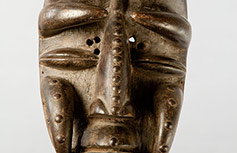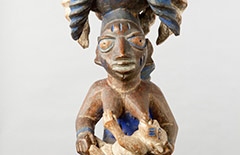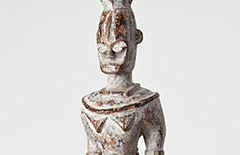Introduction: African Art
In terms of land mass, Africa is a large continent, in which all of the United States, Europe, China, India, Mexico and Japan could easily fit. It is also a place of tremendous diversity, in terms of languages spoken, ethnic identities, cultural traditions, environments in which people live and work, and historic experiences. Sadly, popular culture has profoundly shaped what Africa, Africans, and their rich and diverse cultures are “supposed” to look like, emphasizing the mysterious and exotic. Alas, the same is true of the wide variety of objects produced throughout the continent that all can be called “African art.” Too often it is suggested that such objects are bizarre or creepy, thereby ignoring their beauty and sophistication and totally missing what such objects can reveal about cultures, values and history.
That which can be called African art ranges from what is often labeled traditional sculpture and masks to contemporary painting, photography, ceramics, metal working, and more. And although all are collected today and can be found in art galleries, the former are more likely to have been made and used, with the latter created for aesthetic reasons. Still other forms of African art include personal adornment (made from silver, gold, copper, brass, ivory, wood, clay, animal skin, textiles and beads), as well as intricately carved and woven objects of a practical nature, with some made for everyday personal use and others for only on special occasions. And, of course, there are the objects made for the tourist trade, which can be so authentic-looking, complete with wear and patina, that a collector or buyer needs to be very cautious.
Historically, especially as a result of colonialism, African art, like the peoples of Africa, came to be identified as from a particular “tribe” (sometimes tribal “style” was used to label a piece). Similarly, because it was rare for an object-maker to sign his or her name on the piece, most art from Africa was identified as “anonymous.” Today, we follow a convention that keeps the emphasis on the object being art, and identify the maker as an artist from a particular ethnic group, e.g. “Unknown Yoruba artist.”
Further, what the viewer can see today in a case or on a pedestal is a decontextualized object that rarely gives a hint of the background and circumstances of how the object would have been utilized, or the nature of the social structure of the society that made it. Missing is our ability to see the costumes and dancing, or hear the music, and audience participation that all would typically be part of a mask’s appearance in a community or a sacrifice to a figure in a shrine. Nevertheless, you can still appreciate the object and the skill of the artist who fashioned it, often from a single piece of wood or using a combination of materials, but standing alone a piece of African art cannot give you a sense of its fuller meaning and especially the spiritual importance of some pieces. This presents a serious challenge with any exhibition and is just as true for one mounted online. Nevertheless, we have tried to begin to assist you in acquiring a broader understanding of all that can be involved with a piece of African art by providing a photograph of the object; a map that shows the country from which it comes; and a label with basic information, including what the object is called. If you then follow the link to <Learn more,> you will see additional detailed photographs of the object, a short article with more background about the society that made it and the context of how the object was used. As we are able to gather them, we plan to add photographs of the object in use, and/or a YouTube link that illustrates this.
The objects in the PLU Collection are most easily distinguished as falling into three categories: masks, which transformed the wearer into something or someone else; figures that were used and kept in a home or community shrine; and personal objects that may have been used daily or ceremonially, and which have been made exceptionally well and decorated with unusual care.





